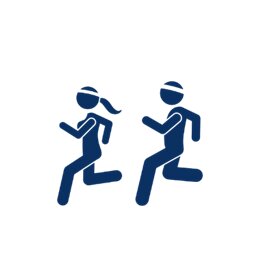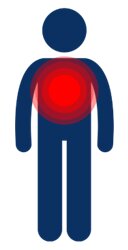What motivates exercise behavior in patients with chronic pain?
Do you know the guidelines for physical activity?
The WHO suggests:

- to do at least 150-300 minutes of moderate-intensity or at least 75-150 minutes vigorous-intensity aerobic physical activity per week.
- to engage in muscle-strengthening activities for all major muscle groups on 2 or more days a week
- to reduce sedentary time as much as possible
And are you aware of the significant health benefits of physical activity, such as the positive effect on your physical health, the prevention of cardiovascular diseases, the positive influence on your mental well-being...?
Yes? Ok great. So are you already halfway out the door to start training for your 10 miles? Probably not.

No worries, you are not alone. Despite the benefits of physical activity, 1 in 4 adults does not meet the guidelines for physical activity.
Physical activity is not just a bonus for an already healthy population. It actually can be a key element within the treatment of diseases and symptoms.
In chronic pain, exercise and physical activity are used as effective treatments to alleviate pain and disability.1
Movement as a medicine.
Chronic pain needs to be understood in a broad context of biological, psychological and social factors. Some other researchers of MOVANT wrote some excellent blogposts on the topic of pain, so make sure you read up on those.
It is estimated that chronic pain affects about 20% of people in Europe.2 Next to the debilitating impact on a person’s life, chronic pain also has an impact at a social and economic level.
We are aware of the need for effective treatment strategies and of the importance of physical activity in treatment. However, we still struggle to design exercise interventions and programs that have good adherence.
So similarly to a healthy population, engaging and keeping up with physical activity is a challenge for patients with chronic pain.
Bad weather, no time, no access to sports facilities are some barriers that anyone can recognize.

Patients who suffer from persistent pain also have other reasons to engage or more importantly not engage in physical activity. Research in a group of patients who suffer from chronic low back pain shows that barriers that they experience are feelings of unsafety when exercising, pain exacerbation or a lack of knowledge towards what is bad or good for their condition.3
Exercise behavior is more than weighing the pros and cons, it is a complex interplay of intention, beliefs, attitudes, social norms, perceived control and actual control.
The research on chronic pain shows that emotional and cognitive factors like beliefs and attitudes have an influence on pain-related outcomes.4, 5 We assume that these factors will also influence physical activity behaviour. However, we do not have a clear understanding of how these factors actually determine physical activity and what aspects we need to address when we want to motivate our patient to be physically active?
That is why we started the Pain-DetAct study, a research project that looks at determinants of physical activity in those who struggle with chronic pain.
Within our study, we look at two different populations. On the one hand, we have chronic low back pain patients and on the other hand, we have cancer survivors with persistent pain.
The background, diagnosis, treatment and lived experience is not the same in these two populations. But exercise as a treatment for persistent pain is the best evidence in both populations.
This distinction in cancer vs non-cancer-related chronic pain is still very present in research and literature. To what extent is this discrimination applicable or needed when we look at interventions for motivating physical activity? Despite the differences within these patients, the struggles that they experience might be similar. Or perhaps, the determining factors are actually different and a one-way approach is not suited.
The aim of the Pain-DetAct study is twofold. One is to understand the determinants of physical activity within each population and the second is to look at how these determinants compare in both populations.
This knowledge will lead to a more in-depth understanding of how we can better support these patients in their exercise journey.

Keep your eye on the MOVANT social media to receive more info on or to be a part of the Pain-DetAct study.
Are you interested in this research? Do not hesitate to contact me at sophie.vandijck@uantwerpen.be.
References
1. Geneen LJ, Moore RA, Clarke C, et al. Physical activity and exercise for chronic pain in adults: an overview of Cochrane Reviews. Cochrane Database Syst Rev 2017; 4: Cd011279. 2017/04/25. DOI: 10.1002/14651858.CD011279.pub3.
2. Breivik H, Collett B, Ventafridda V, et al. Survey of chronic pain in Europe: prevalence, impact on daily life, and treatment. Eur J Pain 2006; 10: 287-333. 20050810. DOI: 10.1016/j.ejpain.2005.06.009.
3. Boutevillain L, Dupeyron A, Rouch C, et al. Facilitators and barriers to physical activity in people with chronic low back pain: A qualitative study. PLOS ONE 2017; 12: e0179826. DOI: 10.1371/journal.pone.0179826.
4. Meulders A. From fear of movement-related pain and avoidance to chronic pain disability: a state-of-the-art review. Current Opinion in Behavioral Sciences 2019; 26: 130-136. DOI: https://doi.org/10.1016/j.cobeha.2018.12.007.
5. Jackson T, Wang Y, Wang Y, et al. Self-Efficacy and Chronic Pain Outcomes: A Meta-Analytic Review. The Journal of Pain 2014; 15: 800-814. DOI: https://doi.org/10.1016/j.jpain.2014.05.002.
PhD student in the MOVANT research group
2021 MOVANTresearch